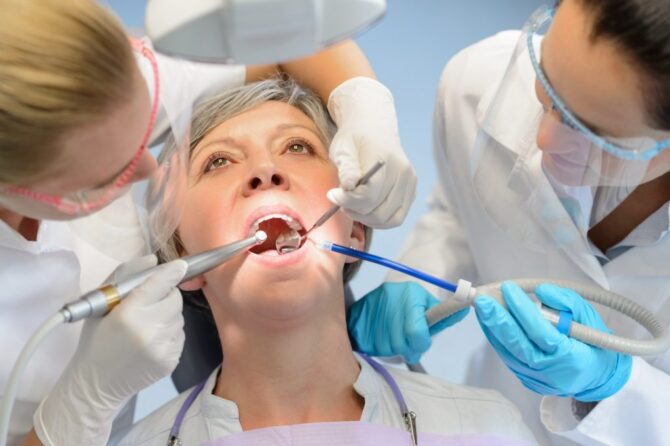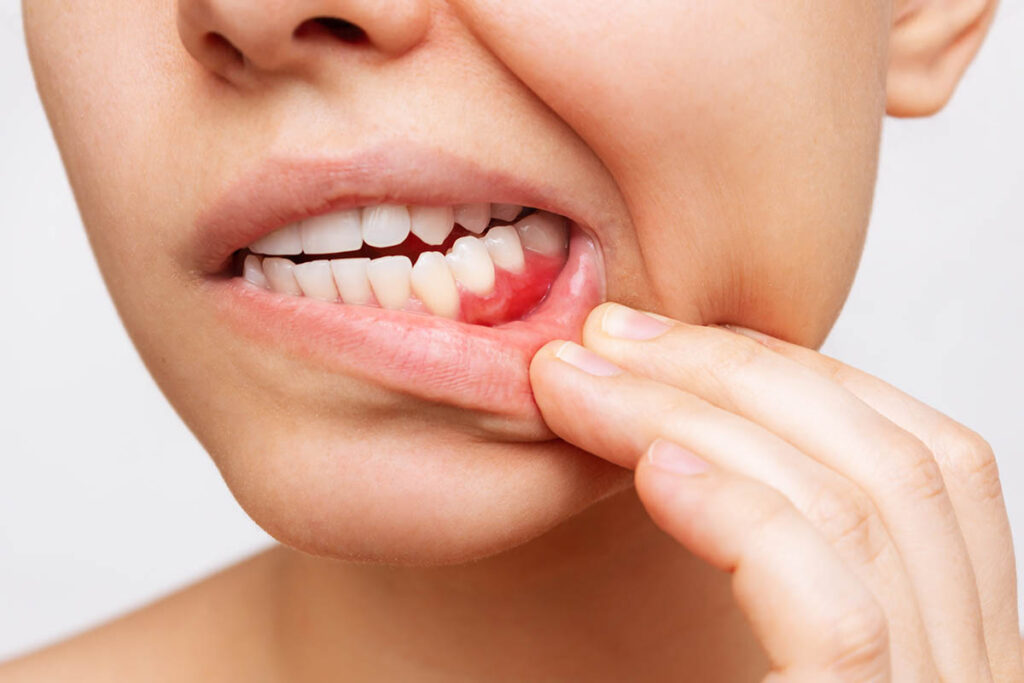
Is Periodontal Disease Contagious- Here’s How to Avoid It!
Periodontal disease is a serious and potentially infectious condition that impacts millions of Americans every year. It is caused by a buildup of plaque and tartar on the teeth and gum line, which can cause the gums to become inflamed, infected, recede and lead to tooth loss. While the causes of periodontal disease can be controlled by good oral hygiene and regular dental visits, it is important to understand if it is contagious to protect yourself and those around you. In this guide, we will discuss the structure of the periodontal tissues, the causes of periodontal disease, its symptoms, diagnostic tests, types of periodontal disease, the contagiousness of periodontal disease, potential transmission methods and risk factors, prevention tips, and treatment options. By understanding the facts surrounding periodontal disease, you can keep yourself and your loved ones safe.
Anatomy and Function of Periodontal Tissues
Our mouths are made up of a complex network of tissues, all of which serve an important purpose. One of these tissues is known as the periodontal tissue, and their primary function is to protect and support our teeth.
The periodontal tissue is made up of four main components: the gingiva (gums), alveolar bone, periodontal ligament and cementum. The gums are the first line of defense against bacteria and food particles from entering the mouth and causing damage. They also provide protection for the root of the tooth, where the periodontal ligament and cementum are located. The periodontal ligament acts to hold the tooth in place and provide cushioning during chewing. The cementum, which covers the root of the tooth, helps to anchor the tooth in the jawbone.
In addition to their protective roles, these tissues also play a vital role in maintaining good oral health. This includes providing nutrients to the tooth and keeping it firmly attached to the jawbone. Without the protective tissues, the tooth can easily become loose and painful, leading to infection and eventual loss of the tooth.
What Causes Periodontal Disease?
Periodontal disease, also known as gum disease, is an infection of the tissues surrounding and supporting the teeth. Poor dental hygiene, genetics and lifestyle can all lead to the deterioration of the periodontal tissues. When left untreated, it can result in the loss of teeth.
Poor oral hygiene is the most common cause of periodontal disease. Brushing and flossing teeth can help reduce plaque build-up, which is a major factor in periodontal disease. Without proper care to remove plaque, bacteria can build up and result in the infection of the tissue.
In addition to poor oral hygiene, genetics can play a role in periodontal disease. Certain individuals may be predisposed to the development of periodontal disease due to their genetic make-up.
Lifestyle can also contribute to periodontal disease. Smoking, stress and certain medications can all weaken the immune system and make it more susceptible to infection. Additionally, some people may not have access to adequate dental care, making them more vulnerable to periodontal disease.

Signs and Symptoms of Periodontal Disease
Periodontal disease is an infection of the tissues around the teeth, and it’s important to know the signs and symptoms of this condition so that you can seek treatment if you have it. Some of the common signs and symptoms of periodontal disease include bad breath, swollen and/or tender gums, tooth sensitivity, receding gums, and loose teeth.
Bad breath or halitosis is one of the most common signs of periodontal disease. This bad smell can be difficult to get rid of and tends to get worse as the condition progresses. Swollen and/or tender gums can also be a sign of periodontal disease, which is usually accompanied by bleeding when brushing or flossing.
Tooth sensitivity is another common symptom of periodontal disease, and can be caused by gums receding away from the teeth. This leaves them more exposed, and more sensitive to hot and cold temperatures. Along with this, receding gums can also cause your teeth to look longer and feel loose, as the supporting bone around them has deteriorated.
If you experience any of these signs or symptoms, it is important to see a dental professional as soon as possible to help diagnose and treat the condition. Early diagnosis and treatment is essential for keeping tooth loss and other serious complications to a minimum.
Diagnosis of Periodontal Disease
If you are concerned that you might have periodontal disease, your dentist or dental hygienist will be able to diagnose it. There are a few tests that are used to diagnose periodontal disease:
- X-Rays: X-rays can detect any damage done to your jawbone and also to the supporting tissue that hold your teeth in place.
- Probing: Probing is a manual test where the dentist can check for periodontal pockets and measure their depth. Pockets that are deeper than 3mm may indicate an infection.
- Plaque Index: This test involves the use of a disclosing dye which reveals how much plaque is present on the tooth surfaces.
By combining these tests, your dentist can accurately diagnose any periodontal disease you may have and help you get the treatment you need.
Types of Periodontal Disease
Periodontal diseases are caused by bacteria that accumulate on the teeth and gums, leading to inflammation and destruction of the periodontal tissues. There are three types of periodontal disease: gingivitis, aggressive periodontitis, and chronic periodontitis.
Gingivitis
Gingivitis is the early form of periodontal disease. It is characterized by red, swollen, and tender gums that are prone to bleeding when brushed or flossed. Gingivitis is reversible with proper dental hygiene and treatment from a dentist.
Aggressive Periodontitis
Aggressive periodontitis is a more serious form of periodontal disease than gingivitis. It usually affects younger people and progresses quickly, leading to the destruction of the gum and bone around the teeth. Early diagnosis and aggressive treatment are needed to prevent further destruction.
Chronic Periodontitis
Chronic periodontitis is the most common type of periodontal disease and develops slowly over time. It is characterized by moderate to severe inflammation of the gums, pockets of infection and destruction of the gum and bone tissue around the teeth. Treatment includes scaling, root planing and other corrective procedures.
Is Periodontal Disease Contagious?
Periodontal disease, also known as gum disease, is a condition that affects the gums and other parts of the mouth. As it can lead to serious consequences such as tooth loss, it is important to understand if periodontal disease is contagious or not.
The good news is that periodontal disease is not a contagious disease and cannot be passed from one person to another through direct contact. However, it can spread indirectly through shared items such as utensils, towels, and toothbrushes. This means that individuals who live in the same household or interact regularly should practice good oral hygiene habits to avoid spreading germs.
The science behind the transfer of periodontal disease is complex but experts believe it involves certain types of bacteria found in saliva and plaque. The bacteria that cause periodontal disease are able to colonize in the mouth and can be spread through contact with saliva and other body fluids.
In addition, other factors such as age and gender can increase the risk of periodontal disease transmission. Women and individuals over the age of 60 are more prone to developing periodontal disease, so it is important to be aware of the potential for transmission among this population.
It is important to remember that although periodontal disease is not contagious, it is still important to take measures to prevent its spread. To reduce the risk of transmission, individuals should brush and floss regularly, use individual oral care items and wear protective mouth guards when participating in contact sports. Practicing these preventive measures will help keep your mouth healthy.
Transmission of Periodontal Disease
Periodontal disease can be spread from person to person, and there are several ways that it can be transmitted. Kissing is one way that the bacteria that cause periodontal disease can be spread, as you can transmit saliva and mucus containing the bacteria that causes this type of disease.
Sharing utensils such as toothbrushes, eating utensils or drinking straws can also transfer bacteria from person to person. Additionally, items such as towels, razors, and lip balms have the potential to carry the periodontal disease-causing bacteria.
It is important to note that not all cases of periodontal disease are contagious. In order for bacteria to be shared, it must move from an infected person, usually through an exchange of bodily fluids, or contact with contaminated surfaces.
Risk Factors of Spread
When it comes to the spread of periodontal disease, certain risk factors can make individuals more vulnerable. Age, gender and poor oral hygiene practices are all major contributors to transmitting the condition from one person to another. Younger people are generally more susceptible to periodontal disease, as their gums may not be as resilient to bacterial infection as those of older individuals. Poor dental hygiene habits such as neglecting to brush and floss regularly can also increase the risk of spreading periodontal disease.
Gender is another factor that has been linked to increased spread of periodontal disease. Studies have suggested that women have a higher likelihood of developing and spreading periodontal disease than men, although the exact reasons for this remain unclear.
Finally, poor oral hygiene practices are a major risk factor in the spread of periodontal disease. By neglecting to brush and floss properly and regularly, bacteria and plaque can build up on teeth and gums, making them more susceptible to infection and thus increasing the chances of transmission.
Prevention of Spread
When it comes to preventing the spread of periodontal disease, there are certain steps you can take to reduce your risk.
Maintaining good oral hygiene is one of the best ways to prevent the spread of periodontal disease. Brushing and flossing your teeth regularly helps to remove bacteria and plaque that could lead to periodontal disease.
It is also important to avoid sharing utensils and other items with someone who may have periodontal disease. This includes toothbrushes, drinking glasses and lip balm.
It is advised to wear a mouth guard when participating in contact sports. This helps to protect your gums and teeth from injury, which can increase the risk of developing periodontal disease.
By taking these simple preventive measures, you can help to reduce your risk of contracting periodontal disease, as well as reducing your chances of spreading it to others.
Treatment of Periodontal Disease
Periodontal disease requires treatment for the patient to experience improved oral health and reduce the risk of further progression. There are several options available when it comes to treating periodontal disease, depending on the severity of the condition. Some of the most common treatments for periodontal disease include:
- Prescribed antibiotics: Depending on the type of bacteria causing the infection, a doctor may prescribe antibiotics to help fight the bacteria.
- Scaling: This procedure involves scaling and cleaning the teeth, removing plaque and tartar from the teeth, and smoothing any rough areas on the surface of the teeth.
- Root planning: This process involves removing any infected or inflamed tissue from the roots of teeth. This can also be done in combination with scaling.
- Laser therapy: A laser can be used to target and remove infected tissue without affecting the surrounding tissue.
- Grafting: When severe gum recession or bone loss occurs due to periodontal disease, a grafting procedure might be necessary to restore the affected area.
Each of these treatments requires an individualized approach that should be discussed with your dentist. It is important to note that, even if the initial symptoms have been eliminated, repeated cleanings may be required to maintain periodontal health.
In conclusion, periodontal disease can be characterized as a progressive and potentially contagious dental condition. While it cannot be completely prevented, understanding the risk factors, signs and symptoms can help with prevention and early detection of the disease. The transmission of periodontal disease is mainly through direct contact, but there are measures that individuals can take to reduce the chances of passing the disease on to others. These include brushing and flossing twice daily, wearing protective mouth gear when playing contact sports, and not sharing eating utensils or drinking cups with others. Additionally, if diagnosed with periodontal disease, treatment should be sought out as soon as possible to prevent further deterioration of the periodontal tissues.
FAQs on Periodontal Disease
- Q: Is periodontal disease contagious?
A: Yes, the transmission of periodontal disease can occur through kissing, sharing utensils and other items, and contact sports. - Q: What are the symptoms of periodontal disease?
A: Symptoms of periodontal disease include bad breath, swollen and/or tender gums, tooth sensitivity, receding gums and loose teeth. - Q: How is periodontal disease diagnosed?
A: Diagnosis of periodontal disease is typically conducted through X-rays, probing, and a plaque index. - Q: What are the types of periodontal disease?
A: Types of periodontal disease are gingivitis, aggressive periodontitis and chronic periodontitis. - Q: What are the risk factors associated with the spread of periodontal disease?
A: Risk factors associated with the spread of periodontal disease include age, gender, and poor oral hygiene practices. - Q: How can we prevent the spread of periodontal disease?
A: People can take steps to prevent the spread of periodontal diseaseby brushing and flossing regularly, not sharing utensils or items with others, and wearing protective mouth gear when playing contact sports. - Q: What is the treatment for periodontal disease?
A: Treatment options for periodontal disease are antibiotic therapy, scaling, root planning, laser therapy and grafting.
